AMQP Connection
This tutorial describes the use of Lobster_data as an AMQP client. You need to have a running AMQP server to receive (AMQP input agent) and send (AMQP response route) messages with a Lobster_data profile. Note: AMQP messages are not to be confused with the internal data/message type Message in Lobster_data. The principle is similar, but the latter is an internal and proprietary message format.
Important note: Please note that Lobster_data itself does not act as a server.
For this tutorial, we will install an AMQP server (RabbitMQ) on a Windows system and create two profiles to receive and send AMQP messages.
Currently, AMQP protocol versions 0.9.1 and 1.0 are supported.
Installation of RabbitMQ and Erlang
Please go to website http://www.rabbitmq.com/install-windows.html (links for other operating systems are available). First, you have to download and install Erlang. Then download the installer for the RabbitMQ server (this tutorial used version 3.4.3) and execute it. This will install a RabbitMQ server service. The service will already be running after the installation and you can use the default setting for the purpose of this tutorial.
Activate Management Plugin
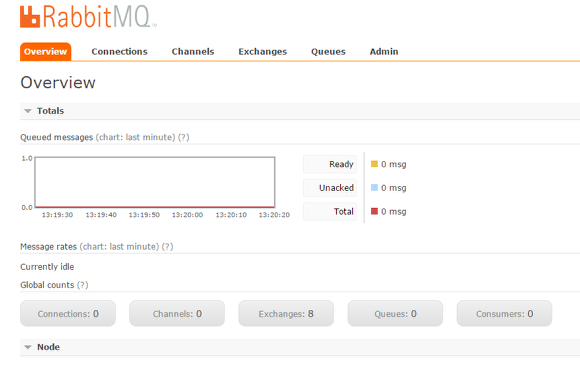
The RabbitMQ server provides a web interface for the management of the server, as you might be familiar to from similar systems. However, you have to enable the management plugin first. Have a look at website http://www.rabbitmq.com/management.html. Open a Windows command console, navigate to folder RabbitMQ Server/rabbitmq_server-3.4.3/sbin/, and execute the command rabbitmq-plugins enable rabbitmq_management.
If you have done everything correctly, you will be able to invoke the website http://localhost:15672/. The default login and password are guest/guest. You will see a web page as shown in the screenshot above.
Create Queue
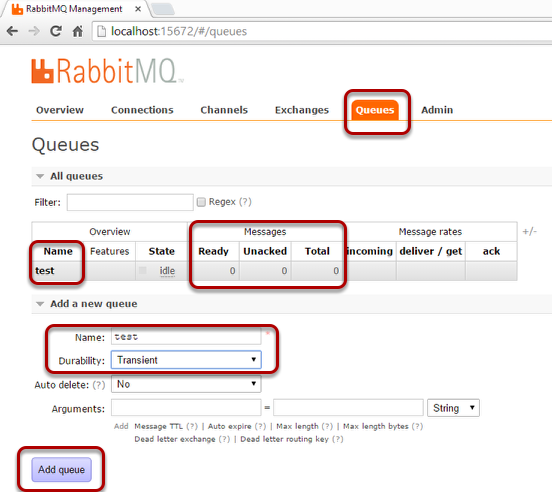
Next, we will create a queue with the name test. Please use the settings shown in the screenshot above.
Manually Publish Message
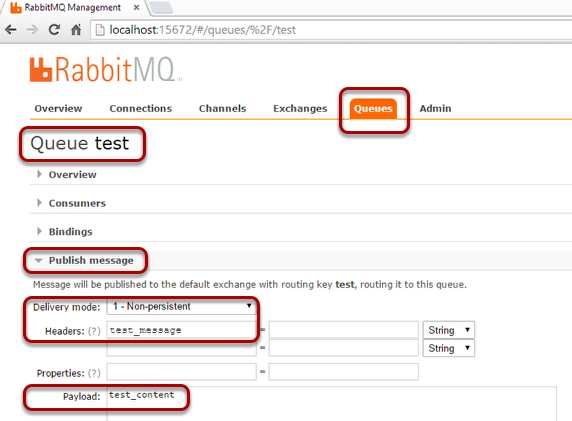
Since we do not have any messages in the new queue yet, we will use the management interface to manually publish a message to this queue. Please proceed as shown in the screenshot above.
Creating AMQP Alias
For the creation of an AMQP alias see section AMQP Connections.
To keep things easy, we will only use a few parameters.

Creating Profile with AMQP Input Agent
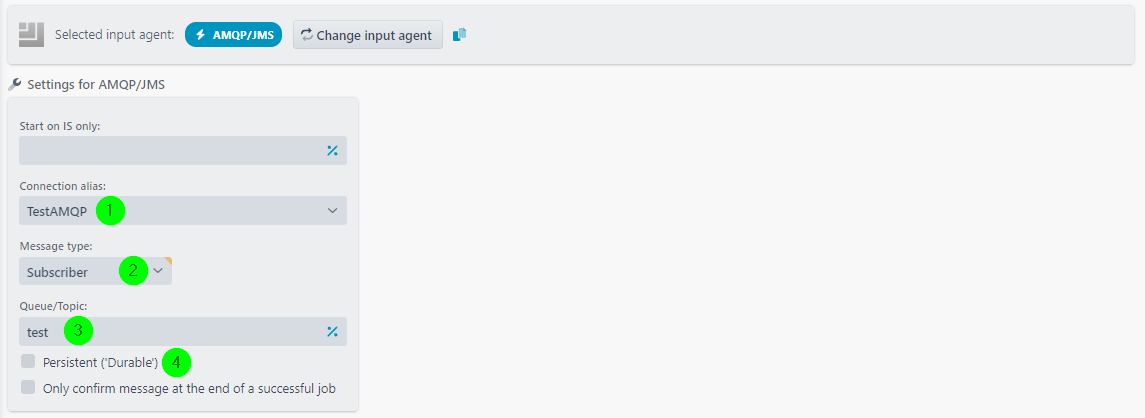
Now create a new profile with an Input Agent of type AMQP. Please use the setting shown in the screenshot above. You can use the option No mapping and leave the response routes empty. Save the profile and make sure it is active. At the latest after a restart of the Integration Server, the connection between Lobster_data and the AMQP server will be established and our profile will listen to queue test as a 'consumer'.
The Parameters
(1) The alias you have set up.
(2) Selection of the Message type: Subscriber, Topic, Routing, RPC. Style RPC is synchronous, the others are asynchronous. Details regarding the different styles can be found in the tutorials at https://www.rabbitmq.com/getstarted.html. In our case, we use Subscriber.
(3) Name of the queue. In our case test.
(4) The option Persistent in an AMQP input agent is necessary if you want to receive messages from a 'durable' queue. Since we created a 'transient' queue in our example, we do not need this option. Details can be found at https://www.rabbitmq.com/tutorials/amqp-concepts.html in section 'Queues'.
New Consumer for Test Queue
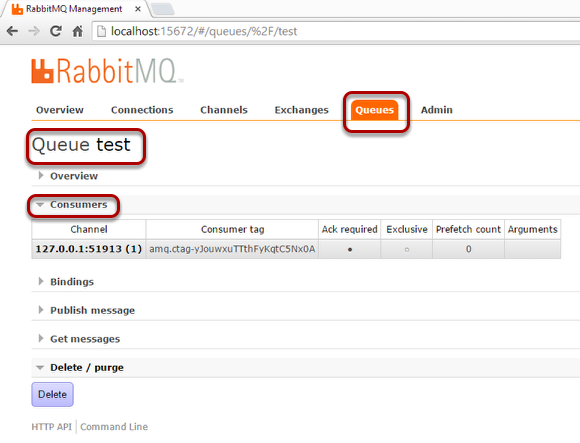
If you have set everything correctly, you will get a view like the one shown in the screenshot above in your management web interface. You will see our profile in the form of a new consumer for the queue test. If you cannot see a consumer, the establishment of a connection has failed. See section 'Connection Error'.
Successful Profile in Control Center
If the connection has been established and the profile was executed and received the message from queue test, you will find a job in the Control Center of Lobster_data. You can view the file (and of course manipulate it in your profile) in the usual manner.
Creating Profile with AMQP Response Route

To be able to send messages to our queue test, we have to create another profile. You can build a small mapping or simply manually upload a text file, use option No mapping, and send the file as received. The only important thing for our example is the response route. Please set it as shown in the screenshot above. If the connection has been established and your message has been published to the queue test, you will again be able to confirm that in the management web interface and the Control Center of Lobster_data. If you are not able to find your message, see chapter 'Connection Error'.
The Parameters
(1) The alias you have set up.
(2) Selection of the type: Publish, Routing, Topic or RPC. Style RPC is synchronous, the others are asynchronous. Details regarding the different styles can be found in the tutorials at 'https://www.rabbitmq.com/getstarted.html'. In our case, we use Publish.
(3) Name of the queue. In our case test.
(4) The option Persistent in a Response Route of type AMQP is necessary if you want to send 'persistent' messages to a 'durable' queue. Since we created a 'transient' queue in our example, we do not need this option. Details can be found at https://www.rabbitmq.com/tutorials/amqp-concepts.html in section 'Queues'.
Connection Error
To investigate a connection error, please open file ./logs/services/error.log.
One possible connection error would result from trying to receive messages from a 'durable' queue, without choosing option Persistent in your AMQP input agent. This would lead to an error message like the following.
16:51:23 SYSTEM:DATAWIZARD:AMQP [AMQP Listener@AMQP] Exception in binding to AMQP queue, retrying in background: java.io.IOException at com.rabbitmq.client.impl.AMQChannel.wrap(AMQChannel.java:106) ... Caused by: com.rabbitmq.client.ShutdownSignalException: channel error; reason: {#method<channel.close> (reply-code=406, reply-text=PRECONDITION_FAILED - inequivalent arg 'durable' for queue 'test' in vhost '/': received 'false' but current is 'true', class-id=50, method-id=10), null, ""} ...Of course, it is possible that your AMQP service is simply not running. This would produce an error message like the following.
18:30:33 SYSTEM:DATAWIZARD:AMQPMANAGER Unable to connect to AMQP server with alias 'TestAMQP', retrying in background: java.net.SocketTimeoutException: connect timed out at java.net.DualStackPlainSocketImpl.waitForConnect(Native Method) at java.net.DualStackPlainSocketImpl.socketConnect(DualStackPlainSocketImpl.java:85) at java.net.AbstractPlainSocketImpl.doConnect(AbstractPlainSocketImpl.java:339) at java.net.AbstractPlainSocketImpl.connectToAddress(AbstractPlainSocketImpl.java:200) at java.net.AbstractPlainSocketImpl.connect(AbstractPlainSocketImpl.java:182) at java.net.PlainSocketImpl.connect(PlainSocketImpl.java:172) at java.net.SocksSocketImpl.connect(SocksSocketImpl.java:392) at java.net.Socket.connect(Socket.java:579) ...